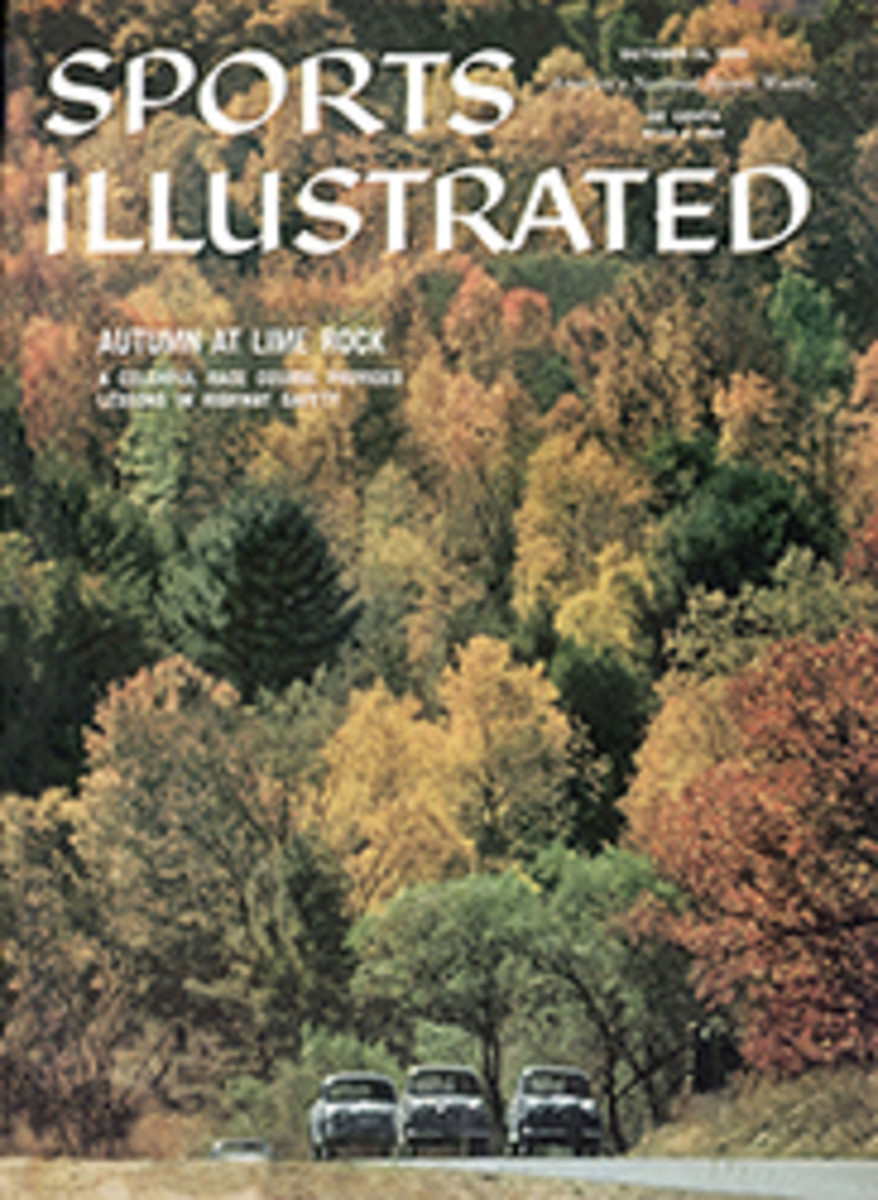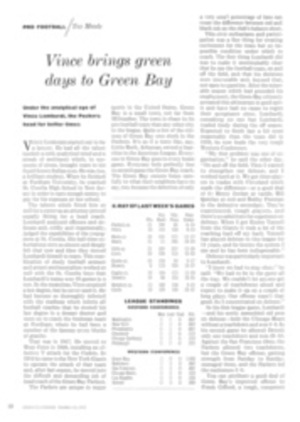
A Bright New Look at the Old Putter
Several years ago a broken right arm stopped my golfing for a while, and I passed the time pitching balls on the putting green one-handed. I used my left arm and a seven-iron. After stroking the balls toward the cup I had to knock them back off the green to start over. If I hit the ball firmly enough to get it off the green the slanted face of the iron dug into the putting turf. So I turned the iron around, using a backhanded stroke with my left arm, and struck the ball with its reverse side.
To my astonishment, the ball hugged the ground and rolled in a line as straight as if it were demonstrating the shortest distance between two points. And I had hit it with only a fraction of the force I used when the ball was struck with the regular face of the iron. Repeating the experiment, using the back sides of other iron clubs with more or less loft than a No. 7, I found the result was the same: the ball hugged the green and rolled straight.
When I analyzed what had happened it became evident that the reverse slope on the back side of the club imparted a forward spin to the ball. The club drove the ball forward while rolling over the ball, as one ball bearing rolls over another. The golf ball consequently moved forward with a spinning motion in the direction of its travel.
I did not then know it, but I had lighted on something that was a hot subject of golf discussion half a century ago. Back in 1900 one William Dunn, an Englishman living in New York, and obviously an expert billiards player, became interested in the application of the technique of billiards to golf shots—or, more exactly, to putting. Reasoning from billiards, Dunn figured that a golf ball with a forward spinning motion "should it strike a small obstruction would jump over it instead of being turned aside." In other words, he thought of a forward-spinning golf ball climbing over obstacles like a tank—an interesting commentary on the condition of American greens in 1900. So Dunn designed and patented a wooden putter with a curved face, the purpose of which was to "deliver a blow which gives the ball that kind of roll which in billiards is known as a 'follow.' "
Later on, three other inventors patented putters of different shapes to produce the same result. Charles Lawton designed one whose face looked like the back of an old-fashioned kitchen ladle. The curve was intended to impart such an overspin that, should the ball "strike a horizontal twig, a pebble or small clod, it climbs over such obstruction instead of being deflected aside thereby."
EXPERT PUTTER FOR BEGINNERS
Lawton recognized that expert players really give golf balls an overspin when they putt, using conventional putters. They do so by keeping their hands slightly ahead of the ball so that the putting blade hits the ball above the center and gives it a vertical forward overspin. He calculated that his rounded-face putter would permit beginners "to give this peculiar motion to golf balls, after little practice, and it therefore assists all players in improving their scores." But experts and beginners alike shied away like skittish horses from the complicated, concave- or convex-faced patented putters. Ninety per cent of the commercially made putters in use now have a 5° loft on the face of the blade. That is, the blade slopes back 5% off the vertical. Striking the ball below the center of gravity, the standard putter imparts a backspin, the reverse of the way Dunn felt a putter should perform.
As I say, I knew nothing of the historical background at the time I made my own discovery. But I began experimenting with a reverse loft on the face of a putting blade. Every regulation golf club has a lofted face. The loft is necessary in the driver and wedge, of course, to get the ball into the air, and to give it a backspin to keep it from rolling forward.
I began by making a putter in which the angle ran the opposite way, first with a reverse loft of about 25°. I took a putter I liked, had used a long time and particularly trusted. (Summarizing 18 months of experiment, I can say the putter to be converted should be a rather thick-blade type, like the Hagen Silver Star, the Wilson Hol-Hi, the Snead Pay-Off, or even a mallet head whose depth of blade is about one inch.)
I took the different putters I converted to a first-class, well-equipped machine shop. First, I had the 5° loft ground off the face of the blade. (All the above-mentioned putters have a 5° loft.) The putter now had a vertical face. Thereafter I began experimenting with different degrees of reverse loft. After these had been ground off, I weighed the putters to find out how much weight had been lost, and added solder, lead or other metal, evenly distributed, to bring the weight back to what it had been before I started grinding.
The first reverse-loft putter I made, with a 25° reverse loft, worked well on short putts. On longer putts, 20 feet or more, the ball had a tendency to jump a little. Eventually, I found that a reverse loft of from 5° to 10° produced a correct vertical overspin, and that a 10° reverse loft gave the best results by far for both short-and long-range putts.
A golf ball has a diameter of 1.68 inches. Half of this is .84 inches. Since the blade of the putter must contact the ball above its horizontal center to produce its forward overspin, the club blade must be at least one inch deep. The reverse-loft putter blade contacts the ball .16 of an inch above the horizontal center. It will provide the overspin itself as long as the putter blade and shaft are vertical at the point of contact and the hands are directly above the ball. There will be no backspin. For greatest accuracy, when hitting the ball the blade should be at a 90° angle to the line of the hole.
This was one of the knottiest problems encountered in the earliest of the putters designed to produce an over-spin in the past. Frederick Plant noted that when a player swung the club in a horizontal arc—that is, parallel with the ground—but did not strike the ball at a point directly in alignment with the hole, the ball went off course. Plant believed that a putter with a blade curved downward would eliminate the horizontal swing entirely, and enable the golfer to produce an overspin with a pendulum swing. It is impossible not to admire the ingenuity of these early practitioners of the art of imparting a top-spin to a golf ball.
But it is also impossible not to feel that they worked too hard at it. They seem to have gone around their elbows to get at their noses. The solution was right there before them on the back side of the standard club—a reverse loft to give the ball an overspin that would make it hug the green and roll straight. What the golfer is trying to do when he putts is to keep the ball on the ground and rolling straight to the hole. His-objective can best be achieved with a blade slanted the opposite direction from the slant on the blade of a driver. Make a reverse-loft putter as I did.
DIAGRAM
DUNN'S DRIVER-STYLE Wood club of 1900 imparted an overspin by riding over ball.
Fig. 2
1
2
4
5
DIAGRAM
CONCAVE CLUB, patented by Doerr in 1922, dipped in at the point of contact.
14
21
24
DIAGRAM
PLANT'S PUTTER of 1922 could be used by right-as well as left-handed golfers.
Fig. 2
a
a
A
DIAGRAM
CONVEX CLUB, also patented in 1922, was Lawton's extreme solution to spin.
2
3
4
5
6
7
8
9
10
14
DIAGRAM
PAYNE'S PUTTER HAS REVERSE 10° left (A), hits ball (B) .16 inch above center (C).
A
B
C

